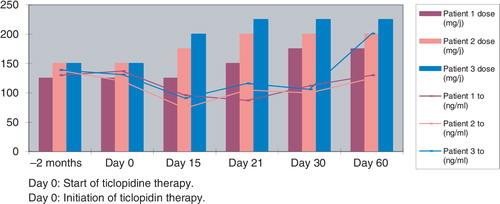Ticlopidine is an effective anti-platelet agent used for prevention of thrombosis Citation1Citation2Citation3. It was reported that treatment with ticlopidine at the dose of 250 mg daily in kidney transplant patients caused significant reduction of cyclosporin A (CsA) blood levels Citation4Citation5. In heart transplant patients treated with higher doses of ticlopidine 500 mg daily, it was found to cause significant decrease of cyclosporin concentration but not in those treated with only 250 mg daily Citation1Citation2. It was thought that ticlopidine interacts with cyclosporin metabolism at cytochrome P450 Citation1Citation2Citation3.
We report three living kidney donor recipients whose blood level of cyclosporin decreased significantly under treatment with a very low dose of ticlopidine of 100 mg daily.
The patients were on immunosuppressive treatment with steroids, CsA, and mycophenolate mofetil (MMF) or azathioprin. The total daily CsA dose was 125–150 mg. The patients developed severe hypertension 15 days to 4 months after kidney transplantation. Serum creatinine was normal except in patient number 2 (). Doppler ultrasonography confirmed significant stenosis of at least 70% degree in the artery of the transplanted kidney. Percutanuous transluminal angioplasty (PTA) with stent placement was performed. Anti-platelet treatment with aspirin (160 mg/day) and ticlopidine (100 mg/day) were given to prevent thrombosis. CsA blood levels were monitored by C0 (before morning dose) (). Under ticlopidine treatment, CsA blood levels decreased in patient 1 from 137 to 112 ng/ml, in patient 2 it decreased from 120 to 100 ng/ml, and in patient 3 it decreased from 131 to 106 ng/ml. Consequently CsA dose had been increased by 50–75 mg/day. No signs of acute kidney transplant rejection were observed.
Fig. 1. Cyclosporin A blood levels (C0) and doses during 60 days of ticlopidine therapy: follow of blood CsA levels and doses in the three patients.

Table 1. Characteristic of three patients with kidney transplantation and renal artery stenosis
In summary: In kidney transplant patients, ticlopidine can cause a significant decrease in CsA blood level even at a low dose of ticlopidine. The interaction of ticlopidine with CsA seems to be not related to the doses. We recommend careful monitoring of CsA blood level in patients treated with ticlopidine.
Tarik Sqalli Houssaïni
Nephrology department
Ibn Sina University Hospital
Rabat, Morocco
Email: [email protected]
Asmaâ Laboudi, Hakima Rhou, Fatima Ezzaïtouni
Loubna Benamar, Naïma Ouzeddoun, Rabea Bayahia
Nephrology department
Ibn Sina University Hospital
Rabat, Morocco
References
- Boissonnat P, De Lorgeril M, Perroux V, Salen P, Batt AM, Barthelemy JC, et al.. A drug interaction study between ticlopidine and cyclosporin in heart transplant recipients. Eur J Clin Pharmacol. 1997; 53: 39–45.
- De Lorgeril M, Boissonnat P, Dureau G, Guidollet J, Renaud S. Evaluation of ticlopidine, a novel inhibitor of platelet aggregation in heart transplant recipients. Transplantation. 1993; 55: 1195–6.
- Campana C, Regazzi MB, Buggia I, Molinaro M. Clinically significant drug interactions with cyclosporin. An update. Clin Pharmacokinet. 1996; 30: 141–79.
- Feriozzi S, Massimetti C, Ancarani E. Treatment with ticlopidine is associated with reduction of cyclosporin A blood levels. Nephron. 2002; 92: 249–50.
- Verdejo A, De Cos MA, Zubimendi JA. Probable interaction between cyclosporin A and low dose ticlopidine. BMJ. 2000; 320: 1037.